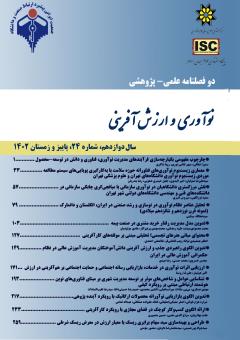تدوین الگوی راهبردی جذب و ارزش آفرینی دانش آموختگان مدیریت آموزش عالی در نظام حکمرانی آموزش عالی در ایران
محورهای موضوعی : تخصصی
محسن خسروي
1
![]() ,
محمد حسنی
2
,
محمد حسنی
2
![]() ,
رضا عیدی
3
,
رضا عیدی
3
![]()
1 - استادیار گروه آموزش علوم تربیتی، دانشگاه فرهنگیان، تهران، ایران
2 - استاد گروه علوم تربیتی، دانشکده ادبیات و علوم انسانی، دانشگاه ارومیه، ارومیه، ایران
3 - گروه آموزش علوم تربیتی، دانشگاه فرهنگیان، تهران، ایران
کلید واژه: آموزش عالی, الگوی راهبردی, حکمرانی, ارزش آفرینی, جذب دانش آموختگان,
چکیده مقاله :
هدف این پژوهش ارائه الگویی راهبردی است که بر اساس آن بتوان جذب و ارزش¬آفرینی دانش¬آموختگان مدیریت آموزش عالی در نظام حکمرانی آموزش عالی در ایران را تبیین نمود. پژوهش حاضر از نظر روش تحقیق از نوع کیفی بوده است. برای ساخت الگوی جذب و ارزش گذاری از نظریه داده بنیاد استفاده شده است. در اینبخش از ۱۸نفر از خبرگان آشنا با موضوع جذب و ارزشگذاری دانش¬آموختگان مدیریت آموزش عالی استفاده شده است. داده به روش مصاحبه نیمه ساختارمند جمعآوری گردیده است. جهت تجزیه و تحلیل دادهها از فرآیند سه مرحلهای کدگذاری باز، انتخابی و محوری با کمک نرمافزار MAXQDA2020 استفاده شده است، که یافتههای این فرآیند نشان دهنده مدل پارادایم جذب و ارزشگذاری دانش آموختگان شامل ۲۷مقوله اصلی و ۹۵متغیر شامل جذب و ارزشگذاری دانش¬آموختگان به عنوان هسته یا مقوله اصلی مدل؛ ۵ شرایط علّی؛ ۳ شرایط زمینهای؛ ۳ شرایط مداخله¬گر؛ ۳ شرایط راهبردی و نهایتاً ۴ پیامد قرار گرفت. در این راستا با توجه به نقش کلیدی دانش آموختگان آموزش عالی در توسعه پایدار دانشی و مهارتی، میطلبد که دانش آموختگان مدیریت آموزش عالی در تدوین و اجرای سیاستگذاریهای کلان تعامل سازنده داشته باشند، و از طریق پاسخگویی شفاف به درخواست آنها، انگیزه آنها برای عهده¬دار شدن مسئولیت کاری در سازمانهای آموزشی و اجرایی افزایش پیدا کند
The purpose of this research is to present a strategic model based on which it is possible to explain the attraction and value creation of higher education management graduates in the governance system of higher education in Iran. The current research was qualitative in terms of research method. Foundation's data theory has been used to build the absorption and valuation model. In this section, 18 experts who are familiar with the topic of attracting and valuing higher education management graduates have been used. Data has been collected by semi-structured interview method. In order to analyze the data, a three-stage process of open, selective and central coding was used with the help of MAXQDA2020 software, and the findings of this process show the paradigm model of attracting and valuing students including 27 main categories and 95 variables including attracting and valuing students as the core. or the main category of the model; 5 causal conditions; 3 background conditions; 3 interfering conditions; 3 strategic conditions and finally 4 consequences were placed. In this regard, considering the key role of higher education graduates in the sustainable development of knowledge and skills, it is required that higher education management graduates have a constructive interaction in the formulation and implementation of macro policies, and through a clear response to their request, their motivation to the increase responsibility for work in educational and executive organizations
